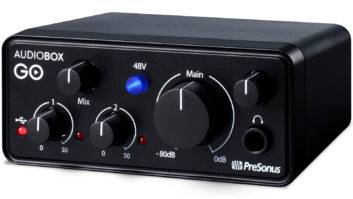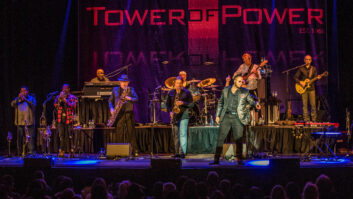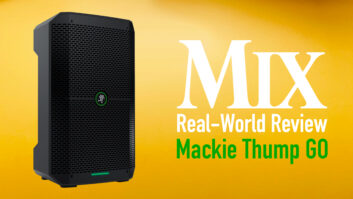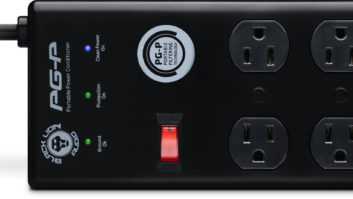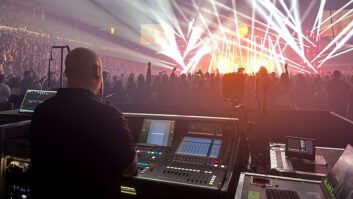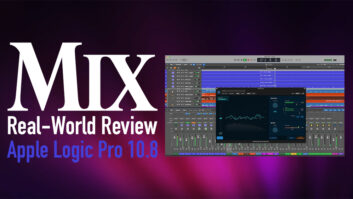Whether used in a small band’s monitor rig or in a multichannel system driving large speaker arrays, a good power amplifier (or three) that can outlast the band is worth its weight in gold on any tour. Like any guitar, keyboard, snare or speaker that must withstand the rigors of the road, a touring power amp must be well-built if the FOH engineer expects it to still be around to power the last chord of the final night’s gig.
Other factors such as flexibility, operating configurations, and circuit overload and heat-protection facilities are also important in making an informed selection for the best amplifier in any live sound application. Can a particular amp be reconfigured as two or more independent units? Is there an automatic cooling fan incorporated to keep things from overheating, and if so, how is it triggered? How many and what type of front panel controls and indicators are available to the user? Does the signal-overload circuitry suit your production’s needs?
Mix queried more than 40 power amp manufacturers to see what’s been released during the past year — up to and including some new releases from AES in New York and this month’s Winter NAMM in Anaheim. Beyond the capsule descriptions presented here, we’ve also provided a list of manufacturer contacts should you need more information.
New from AB International are the 6200D, 6300D and 6600D ($2,549, $2,859 and $3,459, respectively). Each is a 6-channel amplifier in a four-rackspace chassis, and the three models are rated at 200, 400 and 600 watts per channel, respectively, into 4 ohms. A front panel DIP switch provides precise dB attenuation, and channels 1 and 2 can be configured for highpass/lowpass outputs with an optional crossover card. Channel 6 can operate full range or, via built-in 80Hz crossover, as a sub output. Channels are bridgeable in pairs, and both balanced ¼-inch and XLR inputs are provided.
Ashly Audio‘s recent releases include two multichannel, multi-purpose amps, the Powerflex 4400 ($1,379) and Powerflex 6250 ($1,799). The 4-channel 4400 incorporates a high-speed MOSFET switching design with spread-spectrum switching technology, which reduces wasted power and heat. The 45-pound, three-rackspace Powerflex 4400 delivers 275 watts RMS at 8 ohms (400-watts RMS at 4 ohms) from four independent channels, which can be arranged in 2- and 3-channel configurations. Bridged pairs of channels deliver 800W RMS into 8 ohms. The Powerflex 6250 uses the same switching system design as the Powerflex 4400, and its six channels can be bridged in pairs or grouped in 5/4/3-channel configurations. The Powerflex 6250 outputs 250W RMS at 4 ohms, and is designed to function as six independent, 25-volt amps or — in Bridged mode — up to three 70-volt amplifiers.
BGW Systems has expanded its Grand Touring Series. The GT2500 ($1,733), GT3800 ($2,055) and GT5600 ($2,311) feature BGW’s new Class-H PowerEfficient design and faaastLimit™ system protection. All of the new amps offer Neutrik Speakon and five-way barrier strip speaker connections, balanced ¼-inch and XLR inputs, and input attenuators on the front panel detented in 1dB increments. Additional features include mono, stereo and dual-stereo mode switches, and power/signal/clip/limit/protect LEDs. The GT2500 delivers 600 watts at 4 ohms; the GT3800 900 watts at 4 ohms; and the GT5600 produces 1,400 watts at 4 ohms. Frequency response is 20 to 20k Hz (+0, -0.5 dB) for all models.
New from Carvin are the DCM4000 ($2,395 list), the DCM2000 ($1,195) and the DCM1500 ($995). The DCM4000, Carvin’s most powerful amp ever, provides 4,000 continuous RMS-rated watts from a three-rackspace enclosure. Outputting 1,400 watts at 8 ohms, the 4-channel DCM4000 incorporates four independent 1,000-watt amps that can also be configured as two 2,000W amps. Powered by redundant toroid power supplies, the DCM4000 also features switchable limiters, bridge modes, subsonic filters, parallel input sources and ground lifts. Carvin’s DCM1500 and DCM2000 are housed in identical chassis, and, like the DCM4000, are designed for continuous, rather than pulse, full-power performance, for indefinite times without shutdown. Both amps feature 20 to 20k Hz (±1.5 dB) frequency response and a signal-to-noise ratio above 100 dB.
Crest Audio‘s LT Series uses a combination of a linear power supply and a Class-D output to deliver Crest power in a compact and cost-effective package. Features include low current draw, variable-speed fan cooling, rear panel circuit breaker and recessed stepped attenuators with removable knobs. Connections are balanced XLR, ¼-inch TRS, and 3-pin Phoenix inputs with Speakon and binding post outputs. The three models (with power ratings at 4 ohms) include the LT2000 (1,000 watts/channel or 2,400-watts bridged), the LT1500 (750 watts/channel or 1,800W bridged) and the LT1000 (500 watts/channel or 1,000W bridged). All LT Series amps have a 10 to 20k Hz frequency response with THD less than 0.05% at rated power. The LT1000 is $739, the LT1500 is $1,059 and the LT2000 is $1,399.
The Power-Tech 1.1 ($869), 2.1 ($999) and 3.1 ($1,299) amps from Crown Audio are each housed in a two-rackspace chassis, and feature recessed level controls, signal presence, and input/output comparator indicators on the front panel. Rear panel inputs include balanced ¼-inch TRS and XLR jacks, with outputs via a pair of five-way, touch-proof binding posts. The Power-Tech 1.1 provides 305 watts/channel at 4 ohms, the 2.1 offers 325 watts/channel at 8 ohms, and the 3.1 offers up to 760 watts/channel at 4 ohms and 1,525 watts of bridged mono power at 8 ohms. The XLS 202 ($529), XLS 402 ($629) and XLS 602 ($829) are Crown’s new cost-effective live amps designed for mobile DJs and working musicians. Each of these three-rackspace amps have selectable highpass filters (30 Hz/15 Hz/off) and linear optocoupler clip limiters. The amps will drive 2/4/8-ohm loads, and provide from 200 watts (XLS 202) up to 600 watts (XLS 602).
Part of the Eliminator i Series of live sound products, the Electro-Voice Eliminator i ($1,258) and P1201 and P1202 ($1,564 and $1,524, respectively) amps were released at last month’s AES show. The i amplifier’s LPN module compensates for inertial dampening losses for fuller, extended bass response, and the amp is rated at 380 watts/channel at 8 ohms, 600 watts/side at 4 ohms, and 850 watts/channel at 2 ohms. Based on E-V’s Precision Series amps, the P Series offers two front panel slots for modules that include filters and crossovers specifically designed for E-V loudspeakers, such as the newly introduced QRx Series. Both the P1201 and P1202 have XLR and Speakon connections (contractor versions are available with Phoenix and barrier strips), and controls for level control, input/signal present LED and voice-coil protection. The dual-channel P1202 can be used in stereo or mono mode (600 watts/side into 4 ohms), and the P1201 is designed to be used as a 1,200-watt mono power block.
The Symbol 16000 ($2,499) and Symbol 9000 ($1,999) are new offerings from FBT. Both units feature ultra-linear cascade circuits, dual-channel operation with individual volume controls, XLR inputs, Speakon outputs, thermal, DC and short circuit protection, and twin variable-speed cooling fans. Eight bi-color LEDs indicate all operating modes. The 62-pound 16000 pumps out 700 watts at 8 ohms per channel and 1,650 watts at 2 ohms. The 52-pound 9000 provides 500 watts at 8 ohms and up to 2,400W bridged power output. Both amps are covered by a five-year warranty.
Hafler‘s TA1100 ($249) and TA1600 ($379) are two entry-level, dual-channel, dual-rackspace amplifiers targeted at the live sound, DJ and permanent install markets. The latest version of the company’s trans•nova circuitry appears in the TA1600, and the TA1100 sports Hafler’s trans•ana circuitry, resulting in improved clarity and intelligibility. A single red LED signals operating modes and conditions. The TA1100 is rated at 50 watts per channel into 4 ohms (40 watts into 8 ohms); the TA1600 rates at 75 watts into 4 ohms and 60 into 8 ohms. Both units’ frequency response range is 20 to 20k Hz.
The CM Series from Inter-M includes five dual-channel (mono bridgeable) models: CM5.5, CM7.5, CM10.5, CM15.5 and CM20.5. Power ratings range from 175 to 700 watts per channel (8 ohms) and bridged mono output from 550 to 2,100 watts. Standard features include overcurrent and overheating protection circuits, variable-speed fan cooling, Neutrik Combo TRS/XLR balanced inputs, Speakon output jacks and onboard limiter to guard against output overloading.
The flagship of QSC’s PowerLight 2 Series, the PL236-A ($2,160) incorporates PowerWave™ switching technology, offering efficient, cool-running performance under demanding loads. All “A” versions provide internal signal processing, including subaudio filter, clip limiter, crossover controls (frequency, delay and attenuation) and CD horn equalization. Other standard features include a DataPort (for network/control interfacing), variable-speed cooling and protection circuitry against shorts, open circuits, thermal overload, ultrasonics and RF. The 21-pound PL236-A has full bandwidth (20 to 20k Hz) FTC power ratings of 1,100 watts/channel into 4 ohms or 2,400-ohms mono bridged at 8 ohms.
Sekaku‘s PSA Series offers five models: PSA-3450, PSA-3600, PSA-3750, PSA-3900 and PSA-31500. All are 2-channel, two-rackspace units with balanced XLR or ¼-inch TRS inputs, forced air cooling, thermal protection, a circuit breaker reset, and front panel signal and clip LED indicators. A rear panel switch selects onboard 30Hz LF filter in/out, and a choice of stereo (parallel input) or bridged mono operation. The top-of-the-line PSA-31500 uses a Class-H topology; the other PSA amps are Class-AB designs. Full bandwidth power outputs at 4-ohms range from the PSA-3450 at 225 watts/channel (or 650 watts, bridged) to the PSA-31500 at 750 watts/side (2,500 watts bridged).
Stage Accompany‘s ES 40 ($4,047) is a dual-channel power amp featuring the company’s own dynamic-damping control sensing for better control of speaker cone movement and improved mid and bass response. Like all Stage Accompany systems, the ES 40 also features dedicated filter/protection modules for improved output and quality without any chance of mechanical damage, an active clip eliminator without compression effects, and two independent power supplies. Total power output goes as high as 2,850 watts at 2 ohms per channel on the ES 40.
The VS34 Power Plus Digital Power Amp from STK is designed for sustained high-power applications. Power output is 1,250 watts/channel at 4 ohms, 1,700 watts/channel into 2 ohms. Standard features are XLR and ¼-inch inputs, Speakon and binding post outputs, a 30/50Hz selectable low-cut filter, switchable onboard limiter and a multistage digital power supply. Retail is $1,795.
Weighing in at 60 pounds is the HQ-3.4 ($1,195) from Tsunami Technologies with power ratings from 700 watts at 8 ohms to as high as 3,200 watts of bridged power at 4 ohms. Built-in overcurrent detection, speaker protection and DC detection circuits are standard equipment for the HQ-3.4, as are its dual-mode input jacks, binding post and Speakon-type speaker outputs, 21-step detented volume control, temperature sensor and temperature-controlled fan speed. LEDs for power on/off, speaker output signal level, peak level and protection circuit detection are included, and the HQ-3.4 has a frequency response range of 10 to 60k Hz.
The Audiopro A4.4 ($1,799) from Yorkville is a “power-factor-corrected switching power supply amplifier” that delivers 1,200 watts/channel at 4 ohms and 750 watts per side at 8 ohms. The lightweight 26-pound A4.4 includes the company’s front-to-back fan cooling design, a highpass filter and advanced protection circuitry. User controls include a ground lift switch, defeatable limiter switch, and stereo/mono/bridge switch. XLR and ¼-inch balanced inputs and Speakon and binding-post outputs round out the A4.4’s I/O scheme, and the unit is covered by a two-year warranty.
Randy Alberts is a musician, engineer and writer exploring music and recording technology in his Pacifica, Calif.-based studio.
MANUFACTURERS OF AMPLIFIERS FOR LIVE SOUND
The following is a listing of companies that make power amplifiers for live sound applications. Power amps have long lifespans and tend to stay in production for years, and there are many older models not included in this article (yet still in production) that are also excellent choices for live applications.
